InterviewSolution
Saved Bookmarks
This section includes InterviewSolutions, each offering curated multiple-choice questions to sharpen your knowledge and support exam preparation. Choose a topic below to get started.
| 17351. |
Question : Give four important species of honeybee. |
| Answer» SOLUTION :Iratnagar (U.P.) | |
| 17352. |
Question : Give four features in which human beings are considered more advanced than apes. |
| Answer» Solution :Large size of CEREBRAL hemispheres, large cranial cavity (about 1500 cc), erect posture and BIPEDAL locomotion, grasping FORELIMBS for PICKING and carrying objects. | |
| 17353. |
Question : Give four examples of plants cultivated in commercial agroforestry. |
| Answer» SOLUTION :CASUARINA, EUCALYPTUS, TEAK, MALAI vembu. | |
| 17354. |
Question : Give few examples of biofortified crops. What benefits do they offer to the society ? |
| Answer» Solution :Maize, wheat, rice, bathua, spinach, pulses have biofortified varieties. Maize hybrids have twice the amount of amino acids, fortified wheat variety has high protein content, and fortified rice has high quantity of iron. Consumption of such biofortified foods will enrich the nutritive value of our common foods and will vastly improve public HEALTH. Instead of consuming different food items for obtaining different nutrients. If 2 or 3 nutrients can be incorporated into a single CROP it offers enormous BENEFITS to human beings and may even help overcome several nutrient deficiency disorders common in our country. | |
| 17355. |
Question : Give examples to show evolution by anthroponic action. |
| Answer» Solution :EXCESS use of her bicides, pesticides etc. has resulted in selection of RESISTENT varieties in a much lesser time SCALE, Same is TRUE for antibiotic or durg resistant microbes. | |
| 17356. |
Question : Give examples to prove that microbes release gases during metabolism. |
| Answer» Solution :The batter USED for making Dosa and Idali is made by BACTERIA through a matter of fermentation. `CO_2`is PRODUCED in this better so it looks raised | |
| 17357. |
Question : Give examples of unconditional reflexes. |
| Answer» SOLUTION :Blinking of eyes, withdrawing of HAND upon pricking, suckling to breast by infant, SWALLOWING, knee jerk, SNEEZING and coughing are some of the UNCONDITIONAL reflexes. | |
| 17358. |
Question : Name any four chemical mutagens. |
| Answer» Solution :Some chemical mutagens are mustard gas, nitrous ACID, ethyl and methyl METHANE sulphonate (EMS and MMS), ethyl urethane, magnous SALT, formaldehyde, eosin and enthrosine. | |
| 17359. |
Question : Give examples for plants developed for resistance of insect pests. |
Answer» SOLUTION :
|
|
| 17360. |
Question : Give example of the following: (A) An endothermal animal (B) An ectothermal animal (C)An organism of benthic zone |
| Answer» Solution :(A) HUMAN and MONKEY(B) Frog and snake (C ) Star FISH | |
| 17361. |
Question : Give example for Helobial endosperm. |
| Answer» SOLUTION :HYDRILLA and VALLISNERIA. | |
| 17362. |
Question : List the properties of hormones. |
|
Answer» Solution :(1) Hormones are specifically produced in response to a certain stimulus. (2) Depending on nature and intensity of the stimulus, the RATE of secretion of a hormone varies from low to very high. (3) Hormones are produced in one ORGAN and show their effect on distant "target" organ. The source and the target region may be distantly located. (4) Hormones are directly poured in blood circulation and ALWAYS carried through blood. (5) Hormones are always bound to specific carrier proteins while being transported through the blood. (6) Hormones have a high degree of target specificity. (7) Every hormone ACTS basically by modifying some aspect of cellular metabolism. (8) The excessive secretions or deficiencies of hormones may lead to serious DISORDERS. Such disorders are called hyper and hypo-disorders, respectively. |
|
| 17363. |
Question : Give differences Wet deposition and dry deposition |
Answer» SOLUTION :
|
|
| 17364. |
Question : Give differences Primary pollutant and Secondary pollutant |
Answer» SOLUTION :
|
|
| 17365. |
Question : Give differencess Deforestation and Desertification |
Answer» SOLUTION :
|
|
| 17366. |
Question : Give differencess Brown air and Grey air |
Answer» SOLUTION :
|
|
| 17367. |
Question : Give differences BOD and COD |
Answer» SOLUTION :
|
|
| 17368. |
Question : Give differences Afforestation and Agroforestry |
Answer» SOLUTION :
|
|
| 17369. |
Question : Give differences Biological magnification and Eutrophication |
Answer» SOLUTION :
|
|
| 17370. |
Question : Give differences Biodegradable pollutants and Non - biodegradable pollutants |
Answer» SOLUTION :
|
|
| 17371. |
Question : Give differences VNTR and Probe |
Answer» SOLUTION :
|
|
| 17372. |
Question : Give differences Upright Pyramid and Inverted Pyramid |
Answer» SOLUTION :
|
|
| 17373. |
Question : Give differences Unambiguous Codon and Degenerate Codon |
Answer» SOLUTION :
|
|
| 17374. |
Question : Give differences S - shaped and J - shaped growth curve. |
Answer» SOLUTION : 
|
|
| 17375. |
Question : Give differences Restriction Endonuclease and Restriction Exonuclease |
Answer» SOLUTION :
|
|
| 17376. |
Question : Give differences Production and Decomposition |
Answer» SOLUTION :
|
|
| 17377. |
Question : Give differences PCR and plasmid |
Answer» SOLUTION :
|
|
| 17378. |
Question : Give differences Natality rate and Mortality rate. |
Answer» SOLUTION :
|
|
| 17379. |
Question : Give differences National Park and Sanctuary |
Answer» SOLUTION :
|
|
| 17380. |
Question : Draw a neat labelled diagram of neuron. |
Answer» SOLUTION :
|
|
| 17381. |
Question : Draw a neat labelled diagram of stamen of typical flower. |
Answer» SOLUTION :
|
|
| 17382. |
Question :Draw a neat labelled diagram of human sperm. |
Answer» SOLUTION :
|
|
| 17383. |
Question : Draw a neat labelled diagram of human male reproductive system. |
Answer» SOLUTION :
|
|
| 17384. |
Question : With a neat labelled diagram explain the use of Electrostatic precipitator. |
Answer» Solution : Electrostatic precipitator has ELECTRODE wires that are maintained at several thousand volts, which produce a corona that releases ELECTRONS. These electrons attach to dust particles giving them a net negative charge. The collecting plates are grounded and attract the charged dust particles. The velocity of air between the plates must be low enough to allow the dust to fall. IMPORTANCE Electrostatic precipitator can REMOVE over `99%` particulate matter present in the EXHAUST from a thermal power plant. |
|
| 17385. |
Question : Draw a neat labelled diagram of an seminiferous tubule. |
Answer» SOLUTION :
|
|
| 17386. |
Question : Draw a neat labelled diagram of an antibody. |
Answer» SOLUTION :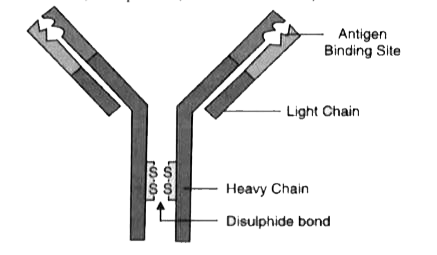
|
|
| 17387. |
Question : Draw a neat labelled diagram of a typical Anatropous ovule of angiosperms. |
Answer» SOLUTION :
|
|
| 17388. |
Question :Draw a neat labelled diagram of a typical agarose gel electrophoresis. |
Answer» SOLUTION :
|
|
| 17389. |
Question : Draw a neat labeled diagram of stirred tank bioreactor. |
Answer» SOLUTION :
|
|
| 17390. |
Question : Draw a neat labelled diagram of T.S. of ovary and describe various phases of menstural cycle. |
Answer» Solution :T.S. of Ovary : 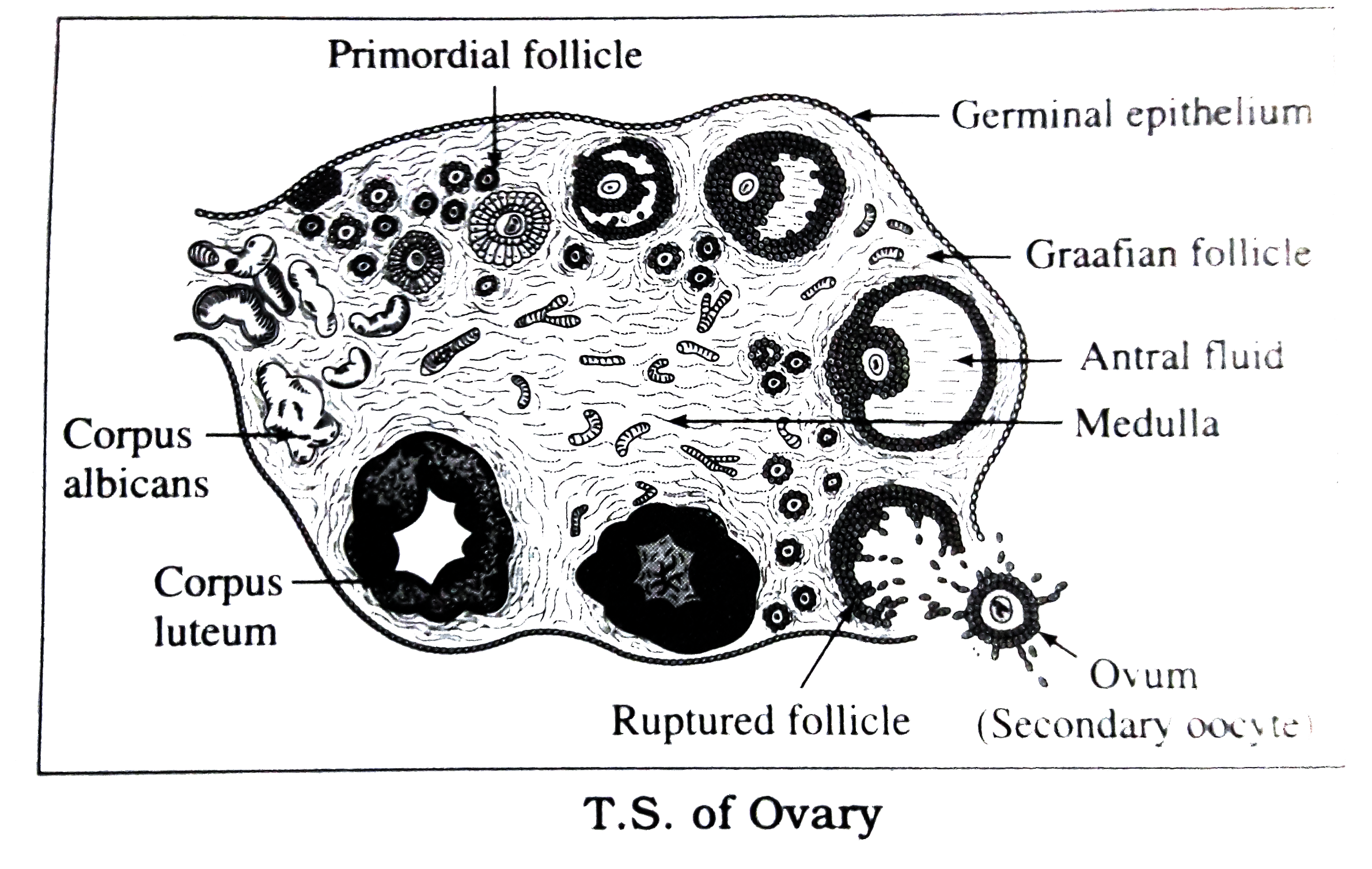 2. Menstrual cycle. (1) Menstrual cycle starts withmenarcheand ends withmeno pause. It lasts forabout 28 days and is repeated throught this period with exception of duration of pregnancy. (2) There are series of changes in uterusand ovariesduring themensturalcycle andthese changes are regulatedby gonadotropinhormonesfrom pituitary and hormones of ovary. (3) Hormones, FSH, LH. estrogenand progesterone are respon-sible for these cyclic changes in mature females. (4) Menstrual cycle is dividedinto four phases , viz., menstrual phase, proliferative phase (in uterus)or follicularphase (in ovary),ovulatory phase,secretoryphase (in uterus)or luteal phase (in ovary). (1) Menstural phase : Menstrual phase 1st to 4th DAY in the absence of fertilization.During this phase bleeding occursas the ENDOMETRIUM of uterusis sloughed off. The thicknessof endometrium becomes 1 mm.After about 4th day of bleeding, once againthe FSH secretionfrom the pituitaryis resumedand the new follicle starts developing. (2)Follicular phase (in ovary)or Proliferativephase (inuterus) : (i) Ovarian chanes : When the ovaryis in follicularphase, the uterusentersin proliferative phase.This takesplacefrom 5thto 13th day of the cycle. During this phase the new primordial follicle in theovary developsdue to theactionof FSHfrom pituitary. Primordial folliclegraduallychangesinto Graafian follicle, producingthe hormone estrogen.Only one follicledevelops in one cycle. (ii) Uterine changes : Theuterus ALSO undergoes proliferation. The endometrial glands of uterusare stimulated and repairprocess of the uterustakes place under tehinfulence of estrogen.The thicnkessof endometrium growsto about 3 mm to 5 mm. (3) Ovulatory phase :Ovulation takes place, onthe 14 th day ofthe cycle. The matureGraffian follicle rupturesdue to LH secreted by the pituitary.The ovumis released in abdominal cavity. This ovum is pickedup by the fimbrineof infundibulum of fallopian tube. It passes throughthe fallopian tube. On its way if it happens to meet sperm, it is fertilized. If UNFERTILIZED , the ovumdegenerates. (4)Luteal phase (Ovary) or Secretory phase (Uterus) : Luteal phase in the ovarycorresponds with the secretoryphase in theuterus . It takes place between15th to 28th day of the cycle. (i) Ovarian changes : In the ovary thecourpus luteumis formed from the EMPTY Graffianfollicle. The corpus luteum produces progestrone. If ovum is fertilizedthe corpuslutuemis retained. Hormones LH and LTH from pituitary help in the maintanceof corpus luteum. If the ovum is ot fertilized , the corpusluteum degenerates and formscorpusalbicans. (ii) Uterine changes : Under the influence of progesterone, ther is increase in the thicnkess of endometrium. Endometrial glandsgrow and become secretory. Thehormone progesterone is responsiblefor the maintenance of pregnancy. If fertilized ovum reaches the uterus. If is implanted and placenta is formed. Thisleadsto pregnancyTill placenta becomes functionalthe corpus luteumkeeps on producing progesterone. If progesterone sourceis cut off, the endometrium sloughs off and themensturation begins, as in case of no conception. |
|
| 17391. |
Question : Draw a neat and well labelled diagram showing T.S.Of ovary and describe the menstrual cycle in human female. |
Answer» Solution :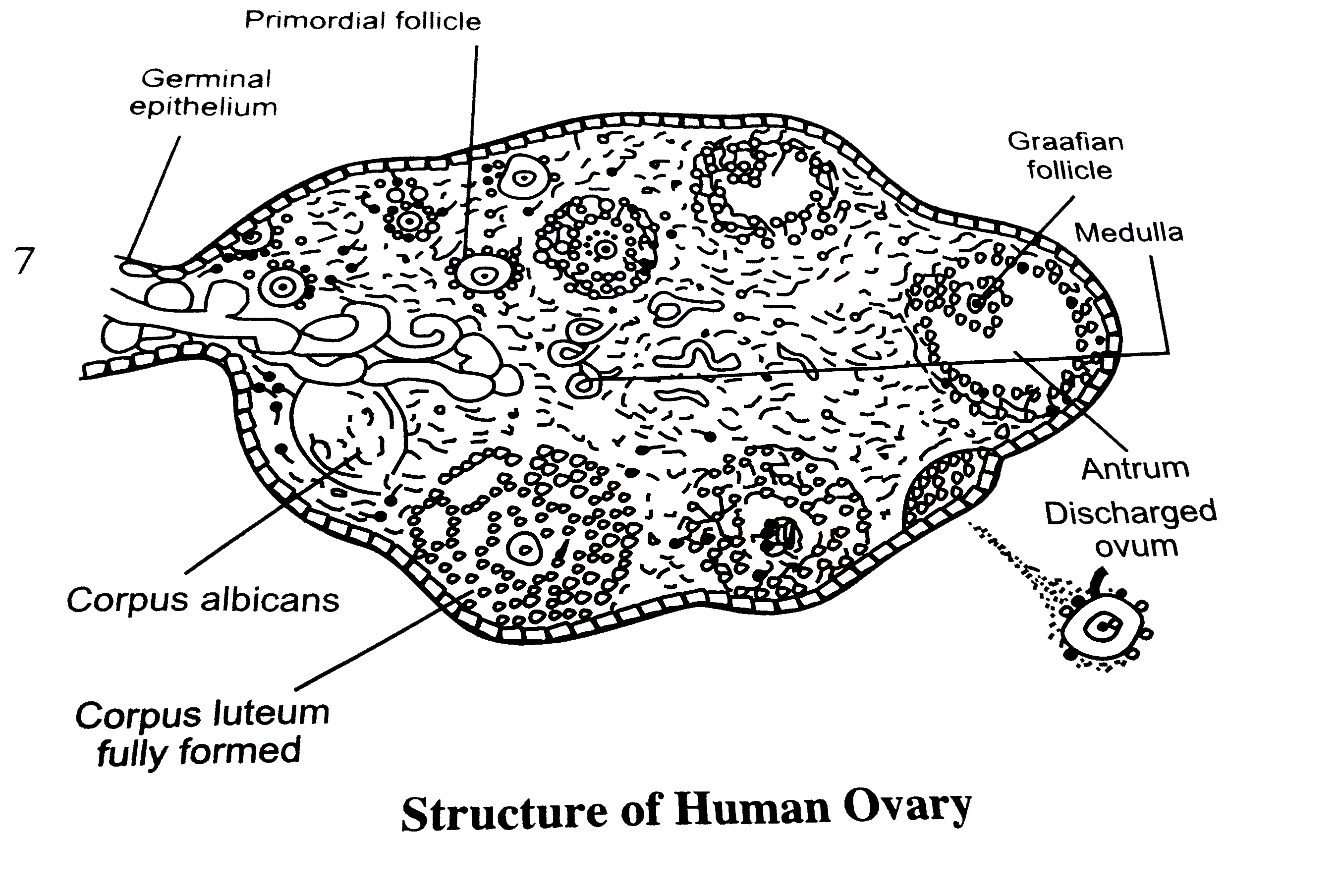 Phases of menstrual cycle : Menstrual cycle is divided into four phases : Menstrual phase : It extends from `1^(st)` to `4^(th)` day of the cycle. It occurs in the absence of fertilisation. During this phase bleeding occurs as the endometrium of uterus is sloughed off. Menstrual flow consists of secretion of endometrial glands, cell debris, unfertilized ovum. After `4^(th)`day, once again the FSH secretion from the pituitary is resumed and the new FOLLICLE starts developing. Follicular phase : When the OVARY is in this phase, uterus enters in proliferative phase. This takes place from 5th to 13th day of the cycle. During this phase new primoridal follicle in the ovary develops due to the action of FSH from pituitary. It gradually changes into graafian follicle and production of estrogen starts. Only one follicle develops in one cycle. Corresponding to the changes in the ovary, uterus also undergoes proliferation. Endometrial glands, stimulated by estrogen do repair process of uterus. Ovulatory phase : During this phase, ovulation takes place. It USUALLY occurs on 14th day. Mature Graffian follicle ruptures due to LH secreted bypituitary. Graafian follicle bursts and releases the ovum. This ovum alon with the follicular fluid is picked up by the fimbriae of infundibulum of fallopian tube. It passes through fallopian tube, where, if it happens to meet a sperm, it is fertilised. If unfertilised, the ovum degenerates. Luteal phase : It corresponds with the secretory phase in uterus. It takes place between 15th to 28th day of the cycle. Ovarian changes : In the ovary, corpus luteum is formed from empty Graafian follicle. Progesterone is secreted now. If ovum is fertilised, corpus luteum is retained. LH and LTH from pituitary help in the maintenance of corpus luteum. If ovum is not fertilised, corpus luteum degenerates and forms corpus albicans. Uterine changes : Under the influence of progesterone, there is increase in the thickness of endometrium. there is increase in the thickness of endometrium. Endometrial glands grow and become secretory. Progesterone is responsible for the maintenance of pregnancy. When fertilised ovum reaches the uterus, it is implanted and placenta is formed. Till placenta becomes functional corpus luteum keeps on producing progesterone. But when progesterone source is cut off, endomertium sloughs off and MENSTRUATION begins. |
|
| 17392. |
Question :Draw a labelled diagram of LS. of an embryo of grass (any six labels). (b) Give reason for each of the following: (i) Anthers of angiosperm flowers and described as dithecous. (ii) Hybrid seeds haveto be produced year after year. |
Answer» Solution : (i) ANTHERS of angiosperms are DESCRIBED as dithecous because each bilobed ANTHER has two theca. (ii) Hybrid seeds have to be produced YEAR after year because PROGENY shows segregation and do not maintain hybrid characters |
|
| 17393. |
Question :Draw a labelled diagram of plasmid PBR 322. |
Answer» Solution : E. coli cloning vector pBR322 showing restriction sites (HIND III, ECOR I, BamH I, Sal 1, PVY II, Pst I, Cla l), ori and antibiotic resistance genes `(amp^(R) " and " tet^(R))`, rop codes for the PROTEINS involved in the replication of the plasmid. |
|
| 17394. |
Question : Draw a labelled diagram of L.S of pistil. |
Answer» SOLUTION :
|
|
| 17395. |
Question : Draw a labelled diagram of human sperm. |
Answer» SOLUTION :
|
|
| 17396. |
Question : Draw a labelled diagram of diagrammatic representation of Miller's experiment. |
Answer» SOLUTION :
|
|
| 17397. |
Question : Draw a labelled diagram of a Biogas plant. |
Answer» SOLUTION :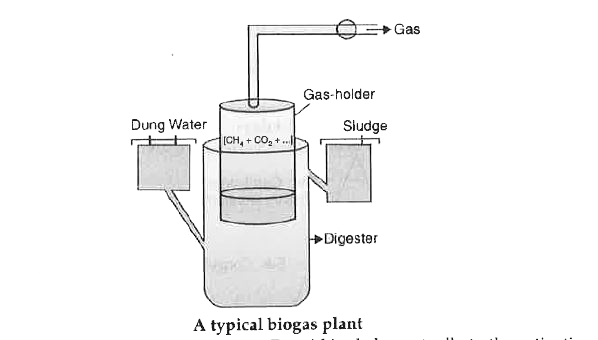
|
|
| 17398. |
Question : Draw a labelled diagram of a Graafian follicle? |
Answer» SOLUTION :
|
|
| 17399. |
Question : Draw a labeled sketch of a spermatozoan. |
Answer» SOLUTION :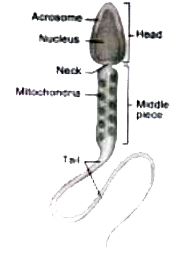
|
|
| 17400. |
Question : Draw a L-from model of tRNA? |
Answer» SOLUTION :
|
|